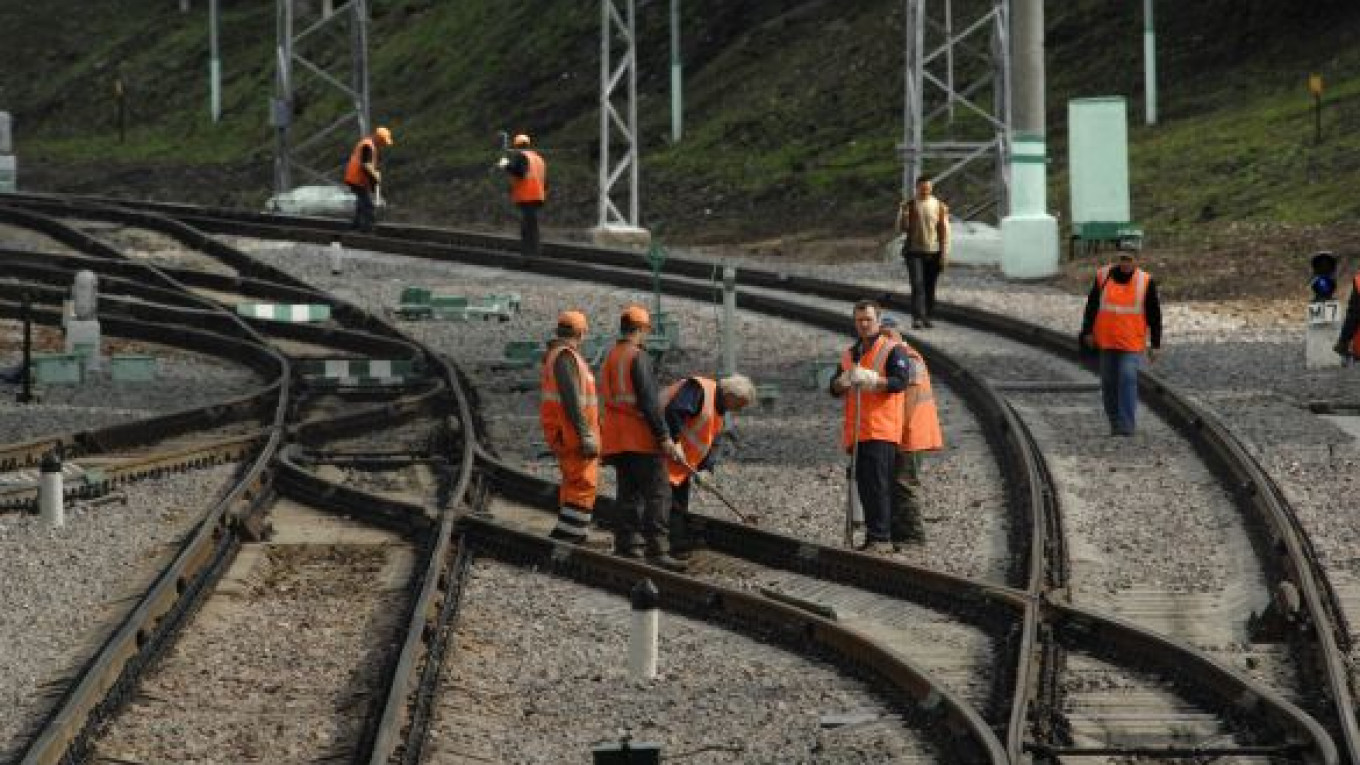A new wide-gauge railway line to Vienna could be a key part of Russian plans to build a Eurasian “land bridge” between China and Europe.
The multibillion-dollar scheme, which would take more than a decade to complete if it gets off the drawing board, would be the most westerly extension of the “Russian” 1,520-gauge railway lines.
Russian Railways officials have enlisted European Union support for their designs to incorporate the Trans-Siberian Railroad into a corridor for freight between the Far East and Europe.
A European Commission delegation headed by Transport Commissioner Siim Kallas gave its backing to the strategy at Russian Railways’ annual conference in Sochi last week.
The proposal, dubbed the Eurasian Land Bridge, is intended to provide a rail-based alternative to traditional sea and air freight routes between far eastern producers and European markets.? ?
Moving cargo by rail costs more and entails a sacrifice of volume in comparison with sea transportation.
But Russian Railways president Vladimir Yakunin said he believed the route would be able to compete on speed.
“They are building ships that can carry 10,000 containers at a time. We can never compete with that,” Yakunin told reporters in Sochi on Friday. “But while we can never increase capacity like that, they can never reduce journey times.”
He said that the option of sending goods by rail would appeal to producers keen to get their goods to market in as little as 14 days, compared with the 40-day sea journey.
He also expressed skepticism about the sustainability of the sea option because deliveries of so many containers at a time would place great strain on the European transportation system.
Some links already exist, including a freight service between the Chinese city of Chongqing and Antwerp in the Netherlands.
But Kallas said in a speech to the conference that there is still a long way to go before the route is commercially viable.
“On tariffs, for example, several countries on the Europe-Asia route, including Russia, apply discriminatory fees to international rail freight that leaves, enters or transits the country. We expect these fees to be phased out as part of Russia’s WTO accession,” he said in a speech to delegates.
Yakunin called on Europe to “cut the red tape that still exists between countries,” while Russia ought to concentrate on becoming a reliable transit route, he said.
Kallas said he expects rail freight between Europe and its Eastern neighbors to grow 30 percent between 2007 and 2020.
Another hindrance is the inconvenient transition between the 1,520-millimeter gauge lines used in the former Soviet Union and the narrow 1,485-millimeter “standard” gauge used in Europe and China.
One solution being pushed by Russian Railways is extending the 1,520-gauge line all the way to a new depot near Vienna, giving direct access to trans-European rail and road networks as well as the Danube River system.
The project, which has yet to attract funding or persuade the governments involved to formally sign up, will take at least 13 years to complete.
“Trains are unlikely to start running before 2025,” said Anton Ryshkov, deputy chief of Russian Railways’ department for economic conjunction and strategic development.
A feasibility study drawn up in 2011 lists three possible financing schemes: public-private partnerships, credit from major lenders and investment banks, and state funding, Ryshkov said.
However, the plan has drawn flak from Poland, where it has been compared to the Nord Stream gas pipeline as an effort to bypass or isolate the Central European country.
Poland says that its own 1,520-gauge line, built in the 1970s to supply iron ore from Ukraine to a steel mill near Katowice, would require only an upgrade and a depot.
It argues that those improvements could be done at a fraction of the cost of building the new railway to Vienna and would give similar access to Central Europe’s rail and road networks.
In another development at the conference, Russia, Kazakhstan and Belarus, which have been united in a customs union since 2010, reached an agreement on the creation of a new logistics company.
Yakunin told reporters that Kazakhstan and Belarus would pay for their stake in the common firm with “funds or assets,” Interfax reported.
Russian Railways plans to borrow 60 billion to 80 billion rubles ($1.9 billion to $2.5 billion) a year over the next three years, partly through issuing eurobonds, in a bid to fund major investment projects.
A Message from The Moscow Times:
Dear readers,
We are facing unprecedented challenges. Russia's Prosecutor General's Office has designated The Moscow Times as an "undesirable" organization, criminalizing our work and putting our staff at risk of prosecution. This follows our earlier unjust labeling as a "foreign agent."
These actions are direct attempts to silence independent journalism in Russia. The authorities claim our work "discredits the decisions of the Russian leadership." We see things differently: we strive to provide accurate, unbiased reporting on Russia.
We, the journalists of The Moscow Times, refuse to be silenced. But to continue our work, we need your help.
Your support, no matter how small, makes a world of difference. If you can, please support us monthly starting from just $2. It's quick to set up, and every contribution makes a significant impact.
By supporting The Moscow Times, you're defending open, independent journalism in the face of repression. Thank you for standing with us.
Remind me later.


